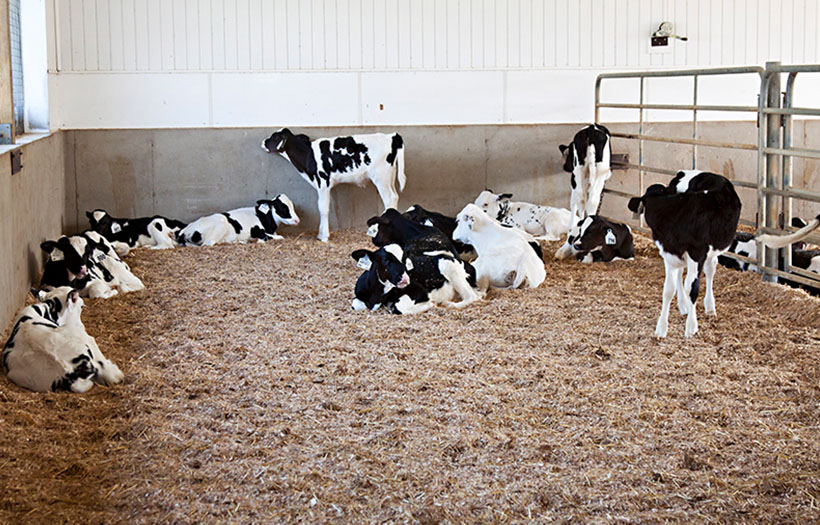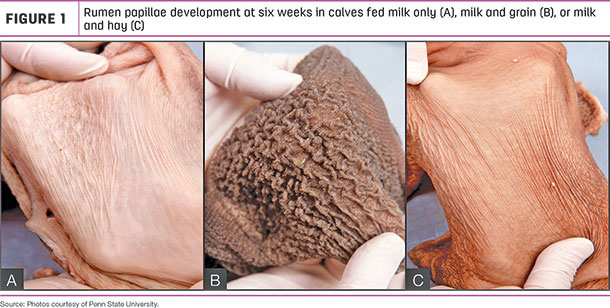Calves and water : Why offering water from day one is essential for proper health and development

Environment to ensure a successful transition period. Providing an optimal stress-free calving area will pay back tenfold. A reason for this long wait time may be due to the belief that calves receive all the water they need from their milk or milk replacer.
While milk and milk replacer are around 87% water, virtually none of it enters the calf’s rumen. When calves drink milk, whether from a bottle or bucket, a reflexive response is initiated that shunts milk via the esophageal groove past the rumen to the abomasum. This bypass mechanism persists in the calf until approximately 12 weeks of age.
When a calf drinks water, it is either doing so out of thirst or curiosity. There is no nervous stimulation or excitement triggering the esophageal groove, and water enters the rumen, where it is an essential ingredient for rumen development. In the rumen, water acts as a substrate for microbial growth (along with bacteria and feed particles the calf has ingested) that kickstarts fermentation and rumen development.
So what happens when you wait?
Studies have shown a calf’s rumen development is slowed when you wait to give it water. In the long term, your herd may be affected by what I like to call post-weaning slump syndrome (PWSS), poor growth rates and, ultimately, lower milk production. When you don’t wait to provide water, other studies have shown increased bodyweight gains and improved starter intake.
Long term, the rumen will be more developed with increased fermentative ability for enhanced health, growth and production.
Water is essential
Water is the most important component of any animal’s body. For a calf, water equals over 50% of its total body composition (80% at birth). Furthermore, water is required in the greatest amount of all nutrients and serves a host of metabolic functions (digestion, reproduction, thermoregulation, etc.).
Since water is essential for digestion and nutrient absorption, it should be offered free choice, beginning day one when calves are moved to hutches or other housing. Beyond cellular functions, water is fundamental for the development of the rumen, initiating starter intake and setting the calf up for post-weaning success.
Rumen development
Within a few days of birth, the calf’s rumen will start developing a population of microbes. These new rumen microbes need water, feed particles and bacteria to grow properly and ferment feedstuffs. Just like water, feeds have the same effect on the esophageal groove. Feed is able to enter the rumen, where it must be digested by microbes or broken down further by rumination.
Rumen development is also affected by the calf’s exploration of its environment. Particles consumed while exploring inoculate the rumen with bacteria. The rumen microbes that survive are those that best digest and utilize feeds eaten by the calf. Water in the rumen provides the media for microbes to live.
This mix of water and microbes in the rumen enables fermentation of carbohydrates leading to volatile fatty acid (VFA) production and rumen papillae growth. Optimal fermentation occurs when approximately four times as much water to dry feed is available in the rumen. I like to look at it like you are feeding two calves, the current monogastric one and the future ruminant.
The monogastric calf receives its primary digestive function and nutrient absorption from the abomasum. The ruminant calf uses water, calf starter and environmental bacteria to grow itself and develop papillae for fermentation. A calf’s abomasum digests milk and those nutrients needed for growth and weight gain now.
Simultaneously, water and grain fed to calves is digested in the rumen and is setting the calf up for continued growth and weight gain in the future. Penn State University shares this comparison (Figure 1) of rumen papillae development at six weeks in calves fed milk only (A), milk and grain (B) or milk and hay (C). It’s evident from the three rumens provided that rumen B, fed both milk and grain, had the greatest papillae growth and rumen development.

The bottom line is that a small amount of grain, along with water, will create fermentation and, therefore, butyric acid production in the rumen. This, in turn, enhances the development of a more functional rumen that can better digest grains and, later in life, forages.
Starter intake
Studies have shown that dry matter intake is directly related to water intake. Over 30 years ago, Kertz et al. showed the benefits of providing free choice water to neonatal calves. Results of the study indicated providing free choice water increased starter intakes by 31% and weight gains by 38% over calves deprived of water.
We know that weight gain during the first two months of life (specifically skeletal and muscle growth) is positively correlated to first-lactation milk yield. Recall that optimum fermentation occurs at a 4:1 ratio, meaning a calf should consume four parts water to each one part starter consumed. By limiting water intake, you are also limiting a calf’s starter intake. Water enables microbial fermentation in the rumen, producing VFAs that result in papillae development. These same papillae then absorb VFAs, which provides nutrition to the rumen and prepares the calf for a smooth postweaning transition.
Post-weaning
Ideally, we want to transition our calves from milk to solid feeds without skipping a beat in health and growth rates. Something many producers face after transitioning calves off milk is PWSS. A PWSS calf drops in bodyweight and often experiences illness due to an underdeveloped rumen. This poorly developed rumen limits dry matter intake, resulting in an inefficient heifer.
In 2018, Iowa State researched the post-weaning benefits of free choice water on 30 calves. Calves were separated into two groups: calves offered water from birth and calves offered water from 17 days on. When following up at five months of age, calves offered water from birth had higher bodyweights than calves offered water from day 17 on (198 kilograms vs 187 kilograms). Their findings concluded that supplying drinking water immediately after birth could improve growth and development of calves pre-weaning and post-weaning, potentially by stimulating rumen development, thus increasing nutrient availability.
A calf can only absorb nutrients from her rumen in proportion to the surface area of the rumen lining. That surface area depends heavily on the growth of papillae – resulting in a greater surface area available for nutrient absorption. With more papillae, heifers have a greater absorptive capacity for the VFAs fermented in the rumen.
Providing water from birth sets your herd’s health and production up for success in both the short and the long term.

Tips for offering water
- Offer it on day one.
- Use a shallower pail for grain and water for the first one to two weeks to train calves where feed and water are.
- Use light-coloured pails; from my farm visits I have seen calves show a preference toward light over dark-coloured pails.
- Place a divider between water and feed buckets or space them far enough apart to prevent calves from carrying feed over to the water pail and vice versa.
- Review water delivery times weekly. Check in with employees to see that milk, water and grain feeding is on schedule.
- Provide clean water daily in clean buckets and as often as needed.
